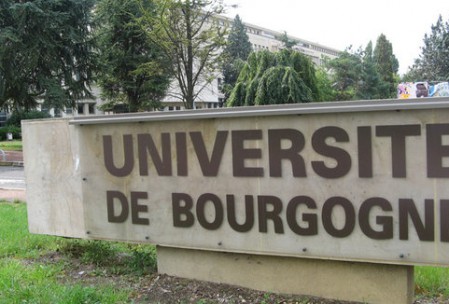AGROECOLOGY JOINT RESEARCH UNIT
The Agroecology Joint Research Unit was created in January 2012 with the University of Burgundy, INRA, AgroSup Dijon, CNRS and the University Hospital Centre. The developed researches lead in the Agroecology Joint Research Unit help to understand the biotic interactions particularly those between plants to plants and between plants to microorganisms. The analysis focuses on agrosystems with the aim to design innovative and environment-friendly systems. In that way, the developed researches answer two major stakes:
- Analyse, understand and act on the interactions and regulations within communities with various spatial and temporal scales.
- Offer innovative systems of cultures to ensure a good agricultural production in sufficient amount, while respecting the environment.
These researches are led to various levels of integration from the molecule to the community and different spatiotemporal scales like microcosm, farm plot, landscape, crop cycle, rotation. They implement complementary expertises such as agronomy; ecology; biology; physiology and ecophysiology; genetics; microbiology and modelling.
The research group (MERS) focuses on the ecology of bacterial human pathogens in outdoor environments. The team investigate intrinsic and extrinsic factors that shape environmental response and adaptation of bacterial human pathogens such as Listeria monocytogenes, our main model. They currently analyse the role of cell-cell communication and the response of Listeria monocytogenes to soil microbiota and rhizosphere through a combination of whole transcriptome analysis, reverse genetics and microcosm assays.
Website of the laboratory : http://www6.dijon.inra.fr/umragroecologie_eng/
Website of the University: http://en.u-bourgogne.fr/
ROLE IN THE PROJECT
The University of Burgundy is the coordinator institution, the leader of the WP5, WP6 and WP8 and manage two projects:
Sub-project 8: Investigation of interconnections between AgrA and σB regulons
The University of Burgundy hosts also 6 Early-stage Researchers (ESR4, ESR3, ESR2, ESR7, ESR5 et ESR6) for their secondment.
STAFF INVOLVED
Pascal PIVETEAU, Coordinator of the network
Education
1996 PhD in microbiology at University College Cork
Professional and teaching experience
Associate Professor Université de Bourgogne, Dijon (France)
Research Interests
Environmental adaptation of pathogenic bacteria – ecology of Listeria monocytogenes – biotic interactions –cell-cell communication in biotic environments
Main recent publications:
-
Vivant A.L., Garmyn D., Gal L., Hartmann A., Piveteau P. 2015. Survival of Listeria monocytogenes in soil requires AgrA-mediated regulation. Appl. Environ. Microbiol. doi: 10.1128/AEM.04134-14
-
Guilbaud M., Piveteau P., Desvaux M., Brisse S., Briandet R. 2015. Exploring the Diversity of Listeria monocytogenes Biofilm Architecture by High-Throughput Confocal Laser Scanning Microscopy and the Predominance of the Honeycomb-Like Morphotype. Appl. Environ. Microbiol. 81:1813-1819
-
Vivant A.L., Garmyn D., Gal L., Piveteau P. 2014. The Agr communication system provides a benefit to the populations of Listeria monocytogenes in soil. Front Cell Infect Microbiol Volume: 4 Article Number: 160 Published Nov 2014 doi: 10.3389/fcimb.2014.00160
-
Vivant A.L., Garmyn D., Piveteau P. 2013. Listeria monocytogenes, a down-to-earth pathogen. Front Cell Infect Microbiol Volume: 3 Article Number: 87 Published Nov 2013
-
Locatelli, A. Depret, G. Jolivet, C. Henry, S. Dequiedt, S. Piveteau, P.Hartmann, A. 2013. Nation-wide study of the occurrence of Listeria monocytogenes in French soils using culture-based and molecular detection methods. J Microbiol Methods. 93 : 242-50.
Contact: piveteau@u-bourgogne.fr
Dominique GARMYN
Education
1994 PhD Univerité catholique de Louvain, Louvain la Neuve Belgique
Professional and teaching experience
Since 1999 : Associate professor at Université de Bourgogne, Dijon, France. Microbiology and molecular biology courses
Research Interests
I am interested in the adaptation of Listeria monocytogenes to its environment and the impact of the communication system. I study the behavior and competitiveness of the bacteria using genetic, transcriptomic data and flow cytometry.
Keywords : Listeriamonocytogenes, soil, rhizosphere, communication, biofilm, phenotypic heterogeneity.
Main recent publications:
-
Vivant, A.-L., D. Garmyn, L. Gal, A. Hartmann, and P. Piveteau. 2015. Survival of Listeria monocytogenes in soil requires AgrA-mediated regulation. Applied and Environmental Microbiology 81:5073-5084.. -.
-
Vivant, A.-L., D. Garmyn, L. Gal, and P. Piveteau. 2014. The Agr communication system provides a benefit to the populations of Listeria monocytogenes in soil. Frontiers in Cellular and Infection Microbiology 4
-
Vivant, A.-L., D. Garmyn, P.-A. Maron, V. Nowak, and P. Piveteau. 2013. Microbial diversity and structure are drivers of the biological barrier effect against Listeria monocytogenes in soil. Plos One 8.
-
Garmyn, D., Y. Augagneur, L. Gal, A.-L. Vivant, and P. Piveteau. 2012. Listeria monocytogenes differential transcriptome analysis reveals temperature-dependent Agr regulation and suggests overlaps with other regulons. Plos One 7
-
Garmyn, D., L. Gal, R. Briandet, M. Guilbaud, J.-P. Lemaitre, A. Hartmann, and P. Piveteau. 2011. Evidence of autoinduction heterogeneity via expression of the Agr system of Listeria monocytogenes at the single-cell level. Applied and Environmental Microbiology 77:6286-6289.
Contact: garmyn@u-bourgogne.fr
Laurent GAL
Education
-
03/1999-/08/1999: Post Doc. Hoechst-Marion-Roussel funding. AFMB laboratory Marseille. “Purification, crystallization and preliminary X-ray analysis of Streptococcus pneumoniae N-acetylglucosamine-1-phosphate uridyltransferase, GlmU”.
-
07/1997-03/1999: Post Doc University of British Columbia. Vancouver Canada. “Deciphering the molecular mechanisms of hydrolysis of some glycosyl hydrolases”.
-
07/07/1997 PhD Université of Provence , Marseille, France.
“Study of the cellulosome of Clostridium cellulolyticum and of one of its components : the CelCCG cellulase”
Professional and teaching experience
-
Since 1999:
Associate professor Agrosup Engineer School. Dijon. France. Microbiology and molecular biology courses
Research Interests
I am interested in the adaptation of Listeria monocytogenes to its environment. I study the behavior of the bacteria in the soil and at the rhizospheric level using genetic, transcriptomic data and microscopy.
Keywords : Listeria monocytogenes, soil, , rhizosphere, Festuca arundinaceae, transcriptome, biofilm.
Main recent publications:
-
Vivant AL, Garmyn D, Gal L, Hartmann A, Piveteau P. Survival of Listeria monocytogenes in Soil Requires AgrA-Mediated Regulation. Appl Environ Microbiol.2015 Aug;81(15):5073-84. doi: 10.1128/AEM.04134-14. Epub 2015 May 22. PubMed PMID: 26002901; PubMed Central PMCID: PMC4495223.
-
Vivant AL, Garmyn D, Gal L, Piveteau P. The Agr communication system provides a benefit to the populations of Listeria monocytogenes in soil. Front Cell Infect Microbiol. 2014 Nov 6;4:160. doi: 10.3389/fcimb.2014.00160.eCollection 2014. PubMed PMID: 25414837; PubMed Central PMCID: PMC4222237.
-
Garmyn D, Augagneur Y, Gal L, Vivant AL, Piveteau P. Listeria monocytogenes differential transcriptome analysis reveals temperature-dependent Agr regulation and suggests overlaps with other regulons. PLoS One. 2012;7(9):e43154. Epub 2012 Sep 14. PubMed PMID: 23024744; PubMed Central PMCID: PMC3443086.
-
Garmyn D, Gal L, Briandet R, Guilbaud M, Lemaître JP, Hartmann A, Piveteau P. Evidence of autoinduction heterogeneity via expression of the Agr system of Listeria monocytogenes at the single-cell level. Appl Environ Microbiol. 2011 Sep;77(17):6286-9. doi: 10.1128/AEM.02891-10. Epub 2011 Jul 1. PubMed PMID:21724873; PubMed Central PMCID: PMC3165395.
-
Garmyn D, Gal L, Lemaitre JP, Hartmann A, Piveteau P. Communication and autoinduction in the species Listeria monocytogenes: A central role for the agr system. Commun Integr Biol. 2009 Jul;2(4):371-4. PubMed PMID: 19721895; PubMed Central PMCID: PMC2734052.
Contact: lgal@u-bourgogne.fr
See the others partners beneficiaries
![]() This project has received funding from the European Union’s Horizon 2020 research and innovation programme under the Marie Sklodowska Curie grant agreement n° 641984
This project has received funding from the European Union’s Horizon 2020 research and innovation programme under the Marie Sklodowska Curie grant agreement n° 641984




